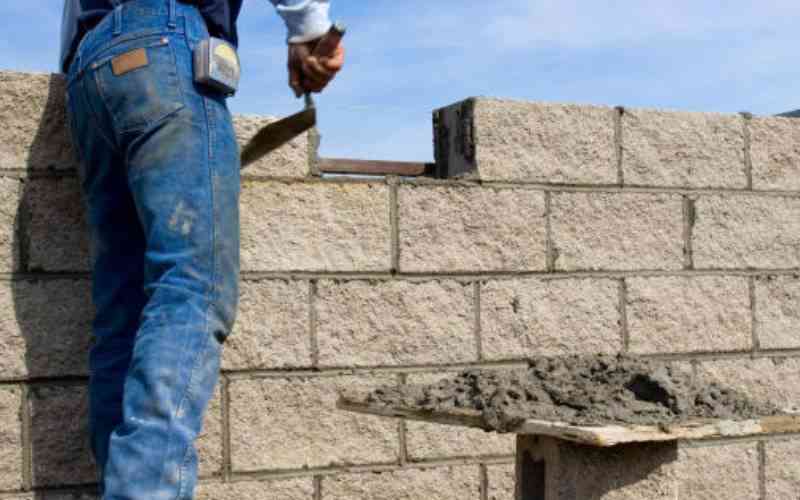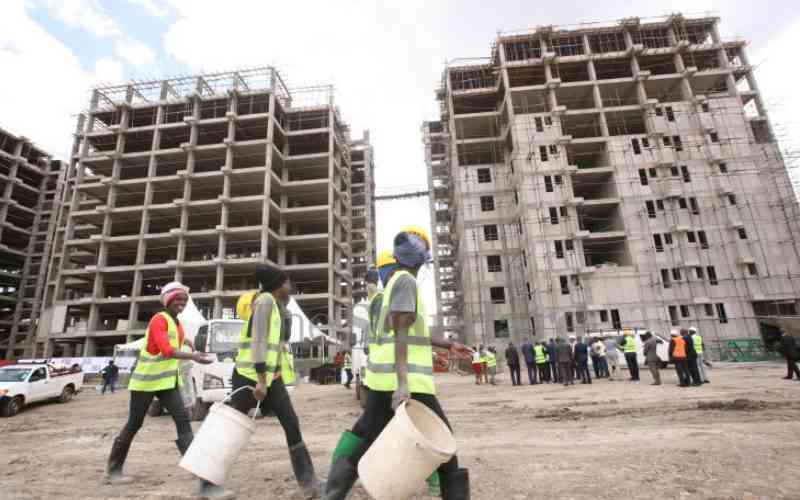The young, the educated, and the princely of the fast-growing middle class who stream back to urban centres are driving up rents in posh areas’ apartments - giving rise to new patterns of gentrification.
Recent Kenya Population and Housing Census data shows that the wealthy who live in Lang’ata and Westlands have rented apartments and in own homes. Lang’ata hosts some of the most popular estates in Nairobi, including Karen and South C.
Westlands, with eight administrative units, hosts some of the country’s upmarket suburbs such as Kitisuru, Lavington, Kilimani, Parklands and Highridge.
Though most of the posh city suburbs have higher incomes, home values, shares of university graduates, as well as professionals, their high-end stature is experiencing a sharp decline in exclusivity.
Cynthia Mambo, who has lived in Kileleshwa for almost half of her life, five of those years in her own apartment, says skyscrapers replacing bungalows have led to congestion, overcrowding and deterioration of infrastructure.
“There are more private schools. Why shouldn’t our kids go to public schools? There are also more apartments than before. I live in a much older apartment that has only 16 houses,” she says.
“Everywhere around me, apartments are mushrooming and with the new houses come malls such as Quickmart, which is perfect for me when I need to shop at 1am, but the traffic is crazy.”
Earlier this year, Cytonn Investments suffered a major setback in its plan to build a Sh20 billion tower next to Cavina School, a British preparatory in Kilimani.
Construction was halted as residents complained of lack of public participation, arguing that the building would have a negative impact on learners. The residents also complained that the project was likely to cause heavy traffic snarl-ups, strain the sewerage system and reduce water supply during peak periods.
According to Cytonn CEO Edwin Dande, Cytonn Towers, Kilimani, is a high-end wealthy population and Cytonn is in the business of making money.
“We are on the right side of the law. We are appealing and the probability is high it will go through so that we proceed to construct the tower,” he said in a phone interview.
“Mixed-use development, such as 14 Riverside, delivers some of the best returns in real estate. Look at Yaya Centre, which has retail, serviced apartments and office blocks. The place is crowded. The demand is there.”
According to Mr Dande, Kilimani used to be a low-density low-rise area like Muthaiga and Karen, but has since been rezoned to high density - meaning you are likely to see tall buildings given that the city is growing. “It is not a matter of posh versus un-posh, but a transition as a result of urbanisation,” he noted.
While a single home would sit on acres of land with manicured lawns, suburbs were strictly intended for residential purposes during the colonial era. Nairobi’s planning, 50 years after independence, largely mirrors its colonial-era image.
White settlers then were strategically positioned in the city’s initial planning in the North and West parts of the city, areas that later earned the name leafy suburbs.
Stay informed. Subscribe to our newsletter
Rezoning policies occurred in 1987, 2006 and 2012, and higher density developments were allowed to be constructed albeit under controlled development.
Nairobi’s population has also grown rapidly at a rate of 4 per cent annually to hit 4.73 million in 2020, according to data by Kenya National Bureau of Statistics. It is estimated to hit five million in 2025. As such, controlled development in some estates cannot be supported given the huge demand for housing - underlining the shift in the type of houses.
This saw the county government introduce a zoning policy in 2017, which allows developers to put up as high as 15 floors from the previous four-floor limit. The areas affected included Zones Four, which comprises Spring Valley, Riverside Drive, Kileleshwa, Kilimani, Thompson and Woodley.
This reduced the areas’ attraction by the super-rich.
Data by Cytonn shows that in 2018 alone there were a total 3,289 approvals for apartment units across the city - underlining the change in taste by real estate developers and residents.
Estates such as Kileleshwa, Kilimani, Parklands, Westlands, Riverside Drive and Upper Hill have seen developers demolish low-density dwelling units to create room for the flats.
Plots in Kileleshwa can now be rezoned for apartments, usually up to 30 on an acre. In Lavington, one can rezone a one-acre plot to accommodate four homes from the previous one single-family unit. “It is not a bad thing; it’s the nature of urban development to cater for the growing population. The same thing is going to happen in Karen. It used to be five acres per house, now it is half an acre per house. It is just densification going on,” opines the Cytonn chief executive.
Karen, another hotbed for the wealthier Kenyans, was once a vibrant residential suburb, characterised by big mansions, many trees, tranquil atmosphere, and plush gardens due to the areas minimum acreage requirement for all homeowners.
Karen and Lang’ata, however, jointly form isolated areas of mid to high-income residents. But the days of glory are long gone.
The Karen and Lang’ata District Association (KLDA) seem to have thrown in the towel, saying graft at City Hall has made it impossible to effect change, with Development Committee Convenor Duncan Munyua scoffing at the idea that Lang’ata still is a high-class residential area.
“We spend all of our time here fighting with City Hall officials but getting nowhere,” he says.
Key effects
Making it to the suburbs, which mainly involves owning a home and escaping the chaos of populated estates, has become the goal of many Kenyans. It is a sign of wealth.
As the Kenyan middle class continues to sprawl, existing infrastructure suffers as maintenance of the available water lines, sewer lines, and roads falter.
“There is a sewer pipe that keeps bursting on our roads right outside our houses. The sewage systems are overwhelmed and more buildings are coming up. I live in a bungalow and now buildings higher than five storeys are allowed to come up right next to your house,” says Nick Ngari, who has lived on Likoni Road for more than 10 years.
According to Ngari, traffic jam has become a menace to the city’s progress. “All these apartments mean more people living in one lane. Everyone has two or more cars and now traffic jam on Dennis Pritt Road is a nuisance. I have to grapple with these changes because I enjoy the proximity to the CBD,” says Ngari.
The once cut-and-dried distinctions between low-income residential and Nairobi suburbs have blurred and no longer explain the actual places we live.
Steven Kisuli, a South C resident who moved from South B about five years ago to escape the developments of buildings, traffic and insecurity, says the mushrooming flats in Nairobi’s affluent areas has made them lose the allure.
“So I settled in South C near the Eka-Next Gen Road. Barely three years in and a multi-storey house has been built right outside my window. I am thinking of moving again.”
Developers now transform a townhouse that previously housed a maximum of six occupants into 50 apartments for 300 residents without expanding the sewage system.
In 2018, Kilimani was the top suburb to receive approvals in apartments at 938 units, and then Parklands, which had 565 apartment approvals according to Cytonn.
Kileleshwa had 495 and South B and C had 421, which shows that people are moving away from the stand-alone houses.
Residents of Kilimani say outstretched amenities is a big issue for the community. Chairman of the Association of Construction Managers of Kenya Nashon Okowa says it is a stretch to still say Nairobi has posh areas.
“The zone regulation is quite outdated for 2020. Kilimani and Kileleshwa are now in Zone Four, which means buildings are only allowed to go four storeys, but we see tall apartments of 10, 12, 15 and even 18 floors on small pieces of land. Those areas would still be posh if we standardised the construction. It is uncontrolled because the regulation is old.”
“The population is rising and ground plus three in posh areas is unattainable. We cannot hinder infrastructure growth, but it has to be controlled in updated zoning policy. A city master-plan, which we lack in Nairobi, can maintain the green spaces and still have high-rise buildings just like in Singapore and Malaysia,” says Nashon.
Despite all of this change, the most affluent areas such as Runda and Muthaiga have largely remained in their glory, thanks to their residents fighting the change.
[email protected]
 The Standard Group Plc is a
multi-media organization with investments in media platforms spanning newspaper
print operations, television, radio broadcasting, digital and online services. The
Standard Group is recognized as a leading multi-media house in Kenya with a key
influence in matters of national and international interest.
The Standard Group Plc is a
multi-media organization with investments in media platforms spanning newspaper
print operations, television, radio broadcasting, digital and online services. The
Standard Group is recognized as a leading multi-media house in Kenya with a key
influence in matters of national and international interest.
 The Standard Group Plc is a
multi-media organization with investments in media platforms spanning newspaper
print operations, television, radio broadcasting, digital and online services. The
Standard Group is recognized as a leading multi-media house in Kenya with a key
influence in matters of national and international interest.
The Standard Group Plc is a
multi-media organization with investments in media platforms spanning newspaper
print operations, television, radio broadcasting, digital and online services. The
Standard Group is recognized as a leading multi-media house in Kenya with a key
influence in matters of national and international interest.








